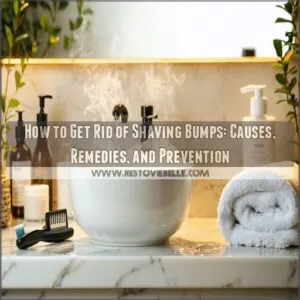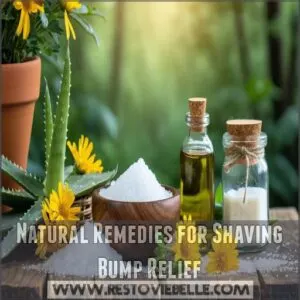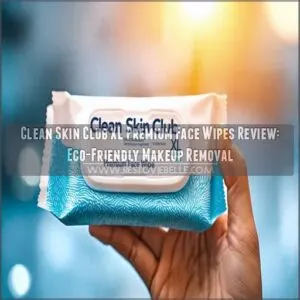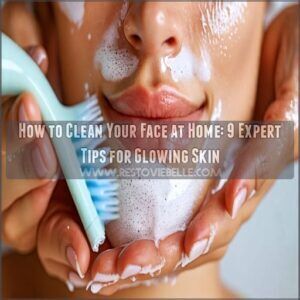This site is supported by our readers. We may earn a commission, at no cost to you, if you purchase through links.
 Want to banish those pesky shaving bumps? Start by giving your skin a break—stop shaving temporarily to let irritation go down.
Want to banish those pesky shaving bumps? Start by giving your skin a break—stop shaving temporarily to let irritation go down.
Use a warm compress to soothe the area, and gently exfoliate with a scrub to prevent ingrown hairs.
Aloe vera or tea tree oil can calm inflammation, while hydrocortisone cream tackles redness and itching fast.
Switch to a sharp razor and shave with the grain to avoid future bumps. For a natural fix, try a baking soda paste or witch hazel.
Still struggling? Laser hair removal might be your ticket to smooth skin heaven. Curious? The full guide awaits!
Table Of Contents
- Key Takeaways
- Shaving Bump Causes
- Get Rid of Shaving Bumps
- Shaving Bump Prevention
- Home Remedies for Relief
- Medical Treatment Options
- Frequently Asked Questions (FAQs)
- How do you get rid of razor bumps asap?
- How long does it take for shaving bumps to go away?
- What heals razor bumps overnight?
- How do you get rid of bumps down there from shaving?
- Does vaseline help razor bumps?
- How to stop razor bumps on pubic area?
- What should I do if I get a bump after shaving?
- What is the best way to remove face bumps?
- How to get rid of razor bumps?
- Should you shave if you have razor bumps?
- Conclusion
Key Takeaways
- Use natural remedies like aloe vera, tea tree oil, or witch hazel to calm inflammation and reduce redness quickly.
- Exfoliate gently and always shave with the grain using a sharp razor to avoid ingrown hairs and irritation.
- Keep your skin hydrated with moisturizers or Vaseline after shaving, and let your skin heal before shaving again.
- If shaving bumps persist, consider long-term solutions like laser hair removal or consult a professional for medical treatments.
Shaving Bump Causes
Razor bumps happen when hair curls back into your skin or grows sideways, causing irritation and inflammation.
They’re more common if you’ve got curly or coarse hair, but anyone can deal with them after a close shave.
Ingrown Hairs and Pseudofolliculitis Barbae
Ingrown hairs and pseudofolliculitis barbae happen when shaved hair grows back into the skin, making it wail in protest with redness, bumps, and itching.
To tackle this:
- Cleanse skin pre-shave to improve follicle health.
- Exfoliate to untrap stubborn hairs.
- Shave smart: Avoid shaving too close.
- Hydrate with soothing creams.
- Use sharp razors for smoother hair follicle care.
Understanding razor bump prevention is key to reducing the occurrence of these issues.
Skin Irritation and Inflammation
Razor bumps aren’t just about ingrown hairs—they bring along skin irritation and inflammation too.
When your razor nicks the surface, it welcomes redness and swelling, especially for sensitive skin.
Sweating or skipping a clean blade worsens it, making inflammation control a headache.
A soothing hack? Try cold compresses or aloe vera for quick redness reduction and efficient razor burn treatment.
Risk Factors for Developing Shaving Bumps
Your skin type and hair texture play a big role in whether you’ll deal with shaving bumps.
Curly hair increases the chance of ingrown hairs and pseudofolliculitis barbae.
Shaving frequency matters too—more shaving can mean more irritation. Genetic predisposition affects susceptibility, especially for darker skin tones.
Understanding these risk factors can help prevent razor burn and stubborn skin irritation. Improper shaving techniques, as seen in razor bumps, can also contribute to the development of pseudofolliculitis barbae.
Common Areas Affected by Shaving Bumps
Shaving bumps can pop up in sensitive and high-friction areas like the face, neck, pubic area, and underarms.
Neck irritation from shaving too closely or repeatedly can lead to ingrown hairs, while underarm rashes often stem from tight-fitting clothes.
Bumps on skin, like razor burn or skin lesions, arise when hair grows back unevenly, inflaming the area, and understanding shaving cause acne is essential to preventing these bumps and maintaining healthy skin, as seen in the link to shaving cause acne, which is crucial for healthy skin and avoiding razor burn.
Get Rid of Shaving Bumps
You won’t need to live with those pesky razor bumps that make your skin look like a strawberry patch gone wrong.
From soothing natural remedies to proven over-the-counter treatments, you’ll find effective solutions to calm your irritated skin and get back to that smooth, bump-free finish you’re after.
Natural Remedies for Shaving Bump Relief
Frustrated with those pesky shaving bumps?
Relief comes straight from nature’s medicine cabinet with gentle cleansers and herbal treatments that calm angry skin.
Here’s what works:
- Baking soda paste soothes inflammation when applied for 20 minutes
- Colloidal oatmeal baths provide natural exfoliant benefits
- Witch hazel acts as a natural skin soother
- Calendula cream promotes healing and hydration
- Hydrocortisone cream reduces redness and irritation
Using aloe vera gel can also provide soothing relief and help reduce inflammation, making it an effective remedy for shaving bumps.
These shaving bump removal remedies work best when used consistently.
Aloe Vera and Tea Tree Oil Benefits
Why suffer through razor burn when nature’s dynamic duo offers sweet relief?
Tea tree oil works as a natural astringent, while aloe vera’s powerful anti-inflammatory properties deliver instant skin relief.
Using aloe vera products can be an effective way to calm irritated skin after shaving.
For natural soothing, mix a few drops of tea tree oil with water and apply it to affected areas.
Follow with pure aloe vera gel for a double dose of herbal remedies that’ll help your skin bounce back.
Exfoliating Scrubs and Warm Compresses
Jump-start your skin’s healing with gentle exfoliants and warm compresses to tackle those stubborn bumps.
Massage sugar scrubs in circular motions while taking warm baths to soften the skin.
For extra relief, press a warm, damp washcloth against affected areas for 30 minutes.
Natural loofahs and skin soothers work wonders for exfoliating skin and reducing razor burn through regular exfoliation sessions.
Over-the-Counter Steroid Creams
While warm compresses bring relief, over-the-counter steroid creams pack a powerful punch against those pesky razor bumps.
A dab of hydrocortisone cream can quickly calm skin inflammation and reduce redness.
You’ll find these creams work wonders for:
- Soothing that maddening post-shave itch almost instantly
- Bringing down swelling and redness within hours
- Helping bumps heal faster with consistent use
- Reducing discomfort during your daily activities
- Preventing future flare-ups when used right after shaving
Just remember, don’t overdo it – these creams work best with short-term use and can be very effective in reducing post-shave itch.
Shaving Bump Prevention
You’ll be amazed at how a few simple changes to your shaving routine can prevent those pesky razor bumps from showing up again.
Whether you’re shaving your face, legs, or sensitive areas, the right techniques and tools will keep your skin smooth and bump-free.
Identifying Shaving Bumps and Ingrown Hairs
Spotting those pesky razor bumps and ingrown hairs isn’t rocket science once you know what to look for.
Shaving bumps appear as tiny, swollen spots that can itch or hurt. You’ll notice single sores or small, red bumps that look like pimples where you’ve shaved.
Understanding the pre shave routine is essential in preventing these bumps from forming.
For curly hair types, ingrown hairs often curl back into the skin, creating raised, tender spots that might feel warm to touch.
Preventing Future Shaving Bumps
Three key preventive measures keep those razor bumps at bay.
Start with proper razor maintenance by replacing your blade after 5-7 uses to prevent irritation and razor burn.
For those with curly or coarse hair texture, consider switching to an electric clipper for gentler hair removal.
Your shaving technique matters too – always go with your hair’s growth pattern, and use a sharp, clean razor for smoother results.
Proper Pre-shave Skin Preparation
Getting your skin ready for a smooth shave is like prepping a canvas – it’s all about the groundwork.
Smart pre-shave prep helps prevent ingrown hairs and skin irritation.
Here’s your pre-shave checklist:
- Start with a gentle skin exfoliation to remove dead cells
- Apply warm water to soften hair follicles
- Pat on pre-shave oil for extra protection
- Let skin rest for 2-3 minutes
- Use a moisturizing shave gel generously
Choosing The Right Razor and Shaving Cream
The best razors combine sharp blades and sturdy Razor Handle Materials for smooth performance.
Match them with Shaving Cream Types—gels for sensitive skin or creams for hydration.
Shave Gel Benefits enhance glide and reduce razor burn.
For ideal shaving, consider a best razor to minimize bumps and ingrown hairs.
Check shaving cream reviews for insights, and master shaving techniques to ace shaving bump prevention.
Home Remedies for Relief
You don’t have to put up with the discomfort of razor bumps when simple remedies can bring relief.
From soothing coconut oil to a cooling oatmeal bath, a few natural solutions can calm your irritated skin and leave it feeling better in no time.
Calendula Cream and Coconut Oil Benefits
Tired of battling razor burn?
Calendula cream and coconut oil are Skin Soothers worth trying. With Herbal Remedies like calendula boosting healing and coconut oil acting as a natural lubricant, these two gems calm irritation and hydrate like pros.
Using calendula skin products can enhance the healing process. Both soothe shaving bumps, repair your Natural Skin Care routine, and keep inflammation at bay.
Bye, razor drama!
Baking Soda Paste Application
Why not turn to a natural powerhouse like baking soda to soothe razor bumps?
This simple paste can calm irritation while reducing inflammation.
- Mix 1 tablespoon baking soda with enough water to form a paste.
- Apply gently to the affected skin.
- Let it dry for 20 minutes.
- Rinse with cool water.
- Repeat once daily for relief.
Colloidal Oatmeal Baths
If baking soda isn’t your thing, a colloidal oatmeal bath might feel like a hug for irritated skin.
Known for calming razor burn and shaving bumps, colloidal oatmeal softens your skin while soothing irritation.
It’s one of the best bath soak remedies for anyone needing quick relief.
Just soak for 10-15 minutes to experience oatmeal skin benefits!
Witch Hazel and Cold Compresses
Feeling itchy? Witch hazel and cold compresses work wonders as skin soothers for shaving bumps and razor burn.
Witch hazel’s astringent properties tackle inflammation, while cold therapy calms irritation fast.
Try these steps:
- Dab witch hazel on bumps for natural relief.
- Apply a chilled compress to cool inflamed skin.
- Repeat twice daily.
- Enjoy smoother, happier skin!
Medical Treatment Options
If home treatments aren’t cutting it, medical options can help tackle stubborn shaving bumps.
From prescription creams to laser hair removal, these solutions target the root causes and bring long-term relief.
Prescription Antibacterial Lotions and Oral Antibiotics
Struggling with bacterial infections from shaving bumps is a common issue that can be addressed with prescription treatments.
These treatments, such as antibacterial lotions or oral tetracyclines, can heal folliculitis fast, offering a solution to those affected.
While medication side effects like irritation are rare, it is crucial to follow your doctor’s advice to ensure safe and effective treatment.
For mild cases, considering natural remedies can also be beneficial in preventing future breakouts.
| Treatment | Use Case | Common Side Effects |
|---|---|---|
| Antibacterial Lotions | Mild skin infections | Rare irritation |
| Oral Tetracyclines | Severe bacterial infections | Gut bacteria imbalance |
| Topical Corticosteroids | Inflammation from bumps | Mild skin dryness |
Sterile Incision and Extraction of Ingrown Hairs
If razor bumps turn into stubborn ingrown hairs, sterile procedures may be needed.
A professional carefully extracts trapped hairs using clean tools to avoid infection, this method targets irritation at its source, promoting skin recovery.
Avoid picking at bumps yourself—leave it to the experts, proper care guarantees healthier hair follicle care and reduces future risk of shaving rash and bumps.
Professional Hair Removal Methods
For stubborn razor bumps, professional hair removal methods can help.
Electrolysis treatment permanently destroys hair follicles, cutting off ingrown hairs at the source.
Waxing techniques and sugaring methods remove hair from the root, reducing irritation.
Meanwhile, threading targets specific hairs for precision.
Exploring these options gives you more control and might beat the endless cycle of shaving struggles.
Laser Hair Removal Benefits
Laser hair removal is a game-changer for razor bumps and shaving irritation.
With permanent results and smoother skin, it minimizes regrowth and eliminates pesky ingrown hair removal hassles.
Say goodbye to shaving irritation and constant upkeep.
It’s cost-effective in the long run, saving you on razors and creams while offering reduced irritation and long-term savings.
Ideal for stress-free hair removal!
Frequently Asked Questions (FAQs)
How do you get rid of razor bumps asap?
Soothe razor bumps fast with aloe vera or hydrocortisone cream to calm inflammation.
Apply a cold compress to reduce redness and swelling.
Exfoliate gently, moisturize the area, and avoid shaving until the skin heals.
How long does it take for shaving bumps to go away?
Shaving bumps usually clear up in about 2 to 3 weeks if you stop shaving and care for your skin.
However, recurring shaving can slow the healing process, so switching techniques might speed things up.
What heals razor bumps overnight?
Think of your skin as a guest needing TLC—apply a dab of aloe vera or hydrocortisone cream to calm irritation.
Try a cold compress to reduce swelling and tea tree oil for quick soothing.
How do you get rid of bumps down there from shaving?
Cool the area with a cold compress, then apply aloe vera for soothing relief.
Stick to loose clothing and try a hydrocortisone cream if irritation persists.
Exfoliate gently to prevent more incoming bumps.
Does vaseline help razor bumps?
Vaseline doesn’t directly treat razor bumps, but it locks in moisture, which helps soothe irritated skin and speeds up healing.
Apply a thin layer after shaving to keep your skin hydrated and irritation-free.
How to stop razor bumps on pubic area?
An ounce of prevention is worth a pound of cure—use a sharp, clean razor and shave with hair growth.
Exfoliate beforehand, apply hydrating shaving gel, and moisturize afterward.
Avoid tight clothing to reduce irritation.
What should I do if I get a bump after shaving?
If you get a bump after shaving, gently cleanse the area, apply aloe vera or hydrocortisone cream to soothe it.
Switch to loose clothing and exfoliate lightly once healed, and avoid shaving over it.
What is the best way to remove face bumps?
Think those bumps will never leave?
Start with a warm compress to reduce inflammation, then apply aloe vera or witch hazel for quick relief.
Exfoliate gently and moisturize daily to prevent them from coming back.
How to get rid of razor bumps?
Fight razor bumps by shaving with the grain, exfoliating beforehand, and applying a soothing moisturizer like aloe vera after.
Switch to sharp, clean blades, or consider alternatives like laser hair removal for smoother results.
Should you shave if you have razor bumps?
Why pour water on a grease fire?
Shaving over razor bumps makes irritation worse and can lead to infection.
Let your skin heal first—try soothing treatments, then shave carefully with proper methods to avoid recurrence.
Conclusion
Shaving bumps can feel like your skin’s way of waging war, but you’ve got plenty of tools to win the battle.
Understanding causes like ingrown hairs and irritation helps you tackle bumps head-on.
Natural remedies, like aloe vera or witch hazel, plus prevention methods like shaving with the grain, can make a difference.
If bumps still persist, explore options like laser hair removal.
Clear, smooth skin is possible when you know how to get rid of shaving bumps for good.

















